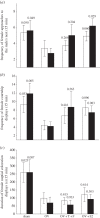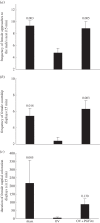Oestradiol and prostaglandin F2α regulate sexual displays in females of a sex-role reversed fish
- PMID: 24452030
- PMCID: PMC3906950
- DOI: 10.1098/rspb.2013.3070
Oestradiol and prostaglandin F2α regulate sexual displays in females of a sex-role reversed fish
Abstract
The mechanisms regulating sexual behaviours in female vertebrates are still poorly understood, mainly because in most species sexual displays in females are more subtle and less frequent than displays in males. In a sex-role reversed population of a teleost fish, the peacock blenny Salaria pavo, an external fertilizer, females are the courting sex and their sexual displays are conspicuous and unambiguous. We took advantage of this to investigate the role of ovarian-synthesized hormones in the induction of sexual displays in females. In particular, the effects of the sex steroids oestradiol (E2) and testosterone (T) and of the prostaglandin F2α (PGF2α) were tested. Females were ovariectomized and their sexual behaviour tested 7 days (sex steroids and PGF2α) and 14 days (sex steroids) after ovariectomy by presenting females to an established nesting male. Ovariectomy reduced the expression of sexual behaviours, although a significant proportion of females still courted the male 14 days after the ovary removal. Administration of PGF2α to ovariectomized females recovered the frequency of approaches to the male's nest and of courtship displays towards the nesting male. However, E2 also had a positive effect on sexual behaviour, particularly on the frequency of approaches to the male's nest. T administration failed to recover sexual behaviours in ovariectomized females. These results suggest that the increase in E2 levels postulated to occur during the breeding season facilitates female mate-searching and assessment behaviours, whereas PGF2α acts as a short-latency endogenous signal informing the brain that oocytes are mature and ready to be spawned. In the light of these results, the classical view for female fishes, that sex steroids maintain sexual behaviour in internal fertilizers and that prostaglandins activate spawning behaviours in external fertilizers, needs to be reviewed.
Keywords: PGF2α; Salaria pavo; oestradiol; prostaglandins; sex steroids; testosterone.
Figures


Similar articles
-
Endocrine control of sexual behavior in sneaker males of the peacock blenny Salaria pavo: effects of castration, aromatase inhibition, testosterone and estradiol.Horm Behav. 2007 Apr;51(4):534-41. doi: 10.1016/j.yhbeh.2007.02.003. Epub 2007 Feb 13. Horm Behav. 2007. PMID: 17368457
-
Brain aromatase mRNA expression in two populations of the peacock blenny Salaria pavo with divergent mating systems.Horm Behav. 2010 Feb;57(2):155-61. doi: 10.1016/j.yhbeh.2009.10.007. Epub 2009 Oct 17. Horm Behav. 2010. PMID: 19840804
-
Social cues in the expression of sequential alternative reproductive tactics in young males of the peacock blenny, Salaria pavo.Physiol Behav. 2012 Oct 10;107(3):283-91. doi: 10.1016/j.physbeh.2012.07.011. Epub 2012 Aug 3. Physiol Behav. 2012. PMID: 22889838
-
Male sexual polymorphism, alternative reproductive tactics, and androgens in combtooth blennies (pisces: blenniidae).Horm Behav. 2001 Sep;40(2):266-75. doi: 10.1006/hbeh.2001.1683. Horm Behav. 2001. PMID: 11534991 Review.
-
Sex steroid levels in Porichthys notatus, a fish with alternative reproductive tactics, and a review of the hormonal bases for male dimorphism among teleost fishes.Horm Behav. 1993 Sep;27(3):332-47. doi: 10.1006/hbeh.1993.1025. Horm Behav. 1993. PMID: 8225257 Review.
Cited by
-
A pheromone receptor in cichlid fish mediates attraction to females but inhibits male parental care.Curr Biol. 2024 Sep 9;34(17):3866-3880.e7. doi: 10.1016/j.cub.2024.07.029. Epub 2024 Aug 1. Curr Biol. 2024. PMID: 39094572
-
The Effects of Synthetic Estrogen Exposure on the Sexually Dimorphic Liver Transcriptome of the Sex-Role-Reversed Gulf Pipefish.PLoS One. 2015 Oct 8;10(10):e0139401. doi: 10.1371/journal.pone.0139401. eCollection 2015. PLoS One. 2015. PMID: 26448558 Free PMC article.
-
Mating behaviors in ovoviviparous black rockfish (Sebastes schlegelii): molecular function of prostaglandin E2 as both a hormone and pheromone.Mar Life Sci Technol. 2024 Jan 19;6(1):15-30. doi: 10.1007/s42995-023-00214-w. eCollection 2024 Feb. Mar Life Sci Technol. 2024. PMID: 38433961 Free PMC article.
-
Testing the "read-across hypothesis" by investigating the effects of ibuprofen on fish.Chemosphere. 2016 Nov;163:592-600. doi: 10.1016/j.chemosphere.2016.08.041. Epub 2016 Aug 28. Chemosphere. 2016. PMID: 27572306 Free PMC article.
References
-
- McCarthy MM, Becker JB. 2002. Neuroendocrinology of sexual behavior in the female. In Behavioral endocrinology (eds Becker JB, Breedlove SM, Crews D, McCarthy MM.), pp. 117–151, 2nd edn. Cambridge, MA: The MIT Press
-
- Fishelson L. 1963. Observations on littoral fishes of Israel I. Behaviour of Blennius pavo Risso (Teleostei, Blenniidae). Isr. J. Zool. 12, 67–91
-
- Patzner RA, Seiwald M, Adlgasser M, Kaurin G. 1986. The reproduction of Blennius pavo (Teleostei, Blenniidae). V. Reproductive behavior in natural environment. Zool. Anz. 216, 338–350
-
- Almada VC, Gonçalves EJ, Oliveira RF, Santos AJ. 1995. Courting females: ecological constraints affect sex roles in a natural population of the blenniid fish Salaria pavo. Anim. Behav. 49, 1125–1127 (doi:10.1006/anbe.1995.0142) - DOI
-
- Saraiva J, Pignolo G, Gonçalves D, Oliveira RF. 2012. Interpopulational variation of the mating system in the peacock blenny Salaria pavo. Acta Ethol. 15, 25–31 (doi:10.1007/s10211-011-0104-y) - DOI
Publication types
MeSH terms
Substances
LinkOut - more resources
Full Text Sources
Other Literature Sources

